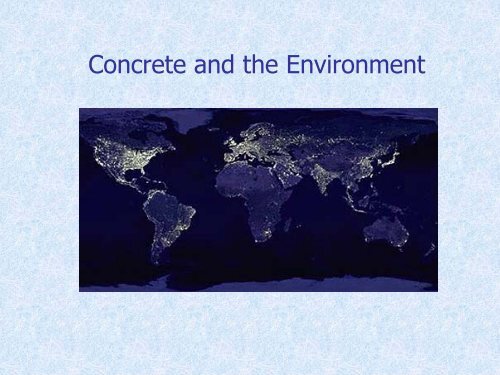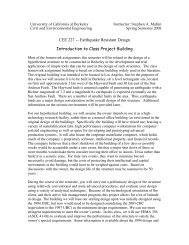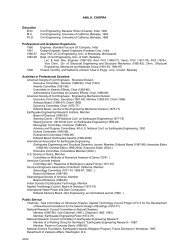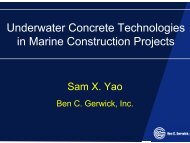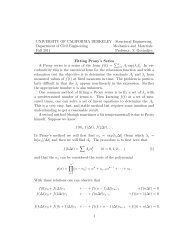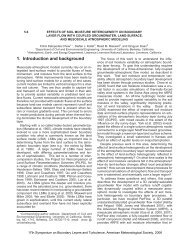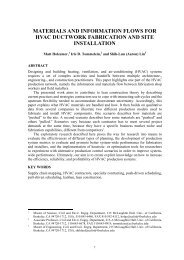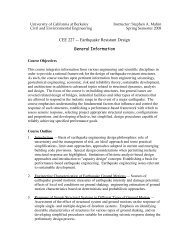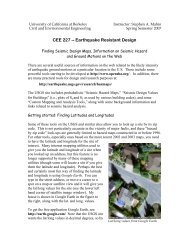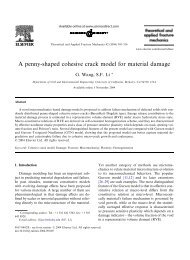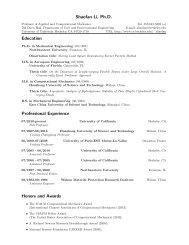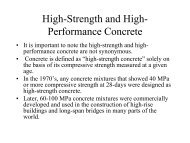Concrete and the Environment
Concrete and the Environment
Concrete and the Environment
Create successful ePaper yourself
Turn your PDF publications into a flip-book with our unique Google optimized e-Paper software.
<strong>Concrete</strong> <strong>and</strong> <strong>the</strong> <strong>Environment</strong>
<strong>Concrete</strong> <strong>and</strong> The <strong>Environment</strong><br />
<strong>Concrete</strong> <strong>and</strong> <strong>the</strong> <strong>Environment</strong><br />
There is increasing concern now that <strong>the</strong> choice of construction<br />
materials must also be governed by ecological considerations<br />
P.K. Mehta <strong>and</strong> P.J.M. Monteiro, <strong>Concrete</strong>: Microstructure, Properties, <strong>and</strong> Materials
<strong>Concrete</strong> <strong>and</strong> The <strong>Environment</strong><br />
Population Growth<br />
• At <strong>the</strong> beginning of <strong>the</strong> 20 th Century, <strong>the</strong> world population<br />
was 1.5 billion; by <strong>the</strong> end of <strong>the</strong> 20 th Century it had risen<br />
to 6 billion. Considering that it took 10,000 years after of<br />
<strong>the</strong> last ice age for <strong>the</strong> population to rise to <strong>the</strong> 1.5 billion<br />
mark, <strong>the</strong> rate of growth from 1.5 to 6 billion people<br />
P.K. Mehta <strong>and</strong> P.J.M. Monteiro, <strong>Concrete</strong>: Microstructure, Properties, <strong>and</strong> Materials
<strong>Concrete</strong> <strong>and</strong> The <strong>Environment</strong><br />
Urbanization<br />
• At <strong>the</strong> beginning of <strong>the</strong> 20 th Century, approximately ten<br />
percent of <strong>the</strong> people lived in cities; in <strong>the</strong> year 2001 nearly<br />
three of <strong>the</strong> six billion inhabitants live in <strong>and</strong> around <strong>the</strong> cities.<br />
P.K. Mehta <strong>and</strong> P.J.M. Monteiro, <strong>Concrete</strong>: Microstructure, Properties, <strong>and</strong> Materials
<strong>Concrete</strong> <strong>and</strong> The <strong>Environment</strong><br />
Technology Choices<br />
• Unfortunately, our technology choices have turned out to be<br />
wasteful because decisions are based on short term <strong>and</strong> narrow<br />
goals of <strong>the</strong> enterprise ra<strong>the</strong>r than a holistic view of <strong>the</strong> full<br />
range of consequences from <strong>the</strong> use of a technology.<br />
P.K. Mehta <strong>and</strong> P.J.M. Monteiro, <strong>Concrete</strong>: Microstructure, Properties, <strong>and</strong> Materials
<strong>Concrete</strong> <strong>and</strong> The <strong>Environment</strong><br />
Waste<br />
• Only 6% of <strong>the</strong> total global flow of materials, some 500 billion<br />
tons a year, actually ends up in consumer products whereas<br />
much of <strong>the</strong> virgin materials are being returned to <strong>the</strong><br />
environment in <strong>the</strong> form of harmful solid, liquid, <strong>and</strong> gaseous<br />
wastes<br />
P.K. Mehta <strong>and</strong> P.J.M. Monteiro, <strong>Concrete</strong>: Microstructure, Properties, <strong>and</strong> Materials
<strong>Concrete</strong> <strong>and</strong> The <strong>Environment</strong><br />
<strong>Environment</strong>al Impact of Technology Choices<br />
• The greatest environmental challenge today is that of <strong>the</strong><br />
human-made climate change due to global warming caused by<br />
steadily rising concentration of green-house gases in <strong>the</strong> earth's<br />
atmosphere during <strong>the</strong> past 100 years<br />
P.K. Mehta <strong>and</strong> P.J.M. Monteiro, <strong>Concrete</strong>: Microstructure, Properties, <strong>and</strong> Materials
<strong>Concrete</strong> <strong>and</strong> The <strong>Environment</strong><br />
Anew vision<br />
• In a nature-centered capitalism, <strong>the</strong> environment will no longer<br />
be treated as a minor factor of production but ra<strong>the</strong>r an<br />
envelope containing, provisioning, <strong>and</strong> sustaining <strong>the</strong> entire<br />
economy.<br />
P.K. Mehta <strong>and</strong> P.J.M. Monteiro, <strong>Concrete</strong>: Microstructure, Properties, <strong>and</strong> Materials
<strong>Concrete</strong> <strong>and</strong> The <strong>Environment</strong><br />
Future Dem<strong>and</strong> for <strong>Concrete</strong><br />
• Ordinary concrete, typically, contains about 12 percent cement,<br />
8 percent mixing water, <strong>and</strong> 80 percent aggregate by mass.<br />
• This means that, in addition to 1.5 billion tonnes of cement, <strong>the</strong><br />
concrete industry is consuming annually 9 billion tonnes of s<strong>and</strong><br />
<strong>and</strong> rock toge<strong>the</strong>r with one billion tonne of mixing water.<br />
P.K. Mehta <strong>and</strong> P.J.M. Monteiro, <strong>Concrete</strong>: Microstructure, Properties, <strong>and</strong> Materials
<strong>Concrete</strong> <strong>and</strong> The <strong>Environment</strong><br />
Future Dem<strong>and</strong> for <strong>Concrete</strong><br />
• The 11.5 billion tonnes-a-year concrete industry is thus <strong>the</strong><br />
largest user of natural resources in <strong>the</strong> world.<br />
• The dem<strong>and</strong> for concrete is expected to grow to approximatelly<br />
18 billion tons (16 billion tonnes) a year by 2050.<br />
• The mining, processing, <strong>and</strong> transport of huge quantities of<br />
aggregate, in addition to billions of tons of raw materials<br />
needed for <strong>the</strong> cement manufacture, consume considerable<br />
energy <strong>and</strong> adversely affects <strong>the</strong> ecology of virgin l<strong>and</strong>s<br />
P.K. Mehta <strong>and</strong> P.J.M. Monteiro, <strong>Concrete</strong>: Microstructure, Properties, <strong>and</strong> Materials
<strong>Concrete</strong> <strong>and</strong> The <strong>Environment</strong><br />
Future Dem<strong>and</strong> for <strong>Concrete</strong><br />
• Both in developed <strong>and</strong> developing countries, gigantic<br />
construction projects are underway in <strong>the</strong> metropolitan areas<br />
not only for new construction but also for rehabilitation or<br />
replacement of existing structures.<br />
P.K. Mehta <strong>and</strong> P.J.M. Monteiro, <strong>Concrete</strong>: Microstructure, Properties, <strong>and</strong> Materials
<strong>Concrete</strong> <strong>and</strong> The <strong>Environment</strong><br />
Reducing <strong>the</strong> <strong>Environment</strong>al Impact of <strong>Concrete</strong><br />
• Portl<strong>and</strong> cement is a product of an industry that is not only<br />
energy-intensive but also responsible for large emissions of<br />
CO2 -- a major green-house gas.<br />
• The manufacture of one ton of portl<strong>and</strong>-cement clinker<br />
releases a ton of CO2 into <strong>the</strong> atmosphere.<br />
• The world's yearly cement output of 1.5 billion tonnes of mostly<br />
portl<strong>and</strong> cement, accounts for nearly 7 percent of <strong>the</strong> global<br />
CO2 emissions.<br />
P.K. Mehta <strong>and</strong> P.J.M. Monteiro, <strong>Concrete</strong>: Microstructure, Properties, <strong>and</strong> Materials
<strong>Concrete</strong> <strong>and</strong> The <strong>Environment</strong><br />
Industrial ecology<br />
• The waste product of one industry is recycled as a substitute<br />
for virgin raw material of ano<strong>the</strong>r industry, <strong>the</strong>reby reducing<br />
<strong>the</strong> environmental impact of both.<br />
P.K. Mehta <strong>and</strong> P.J.M. Monteiro, <strong>Concrete</strong>: Microstructure, Properties, <strong>and</strong> Materials
<strong>Concrete</strong> <strong>and</strong> The <strong>Environment</strong><br />
Oportunities<br />
• Over a billion tons of construction <strong>and</strong> demolition wastes are<br />
being disposed of in road-bases <strong>and</strong> l<strong>and</strong>fills every year, in<br />
spite <strong>the</strong> fact that cost-effective technologies are available to<br />
recycle most of it as a partial replacement for coarse aggregate<br />
in concrete mixtures.<br />
P.K. Mehta <strong>and</strong> P.J.M. Monteiro, <strong>Concrete</strong>: Microstructure, Properties, <strong>and</strong> Materials
<strong>Concrete</strong> <strong>and</strong> The <strong>Environment</strong><br />
Opportunities<br />
• Most waste-waters <strong>and</strong> undrinkable natural waters can be<br />
substituted for municipal water for mixing concrete unless<br />
proven harmful by testing.<br />
P.K. Mehta <strong>and</strong> P.J.M. Monteiro, <strong>Concrete</strong>: Microstructure, Properties, <strong>and</strong> Materials
<strong>Concrete</strong> <strong>and</strong> The <strong>Environment</strong><br />
Opportunities<br />
• Blended portl<strong>and</strong> cements containing fly ash from coal-fired<br />
power plants <strong>and</strong> granulated slag from <strong>the</strong> blast-furnace iron<br />
industry provide excellent examples of industrial ecology<br />
because <strong>the</strong>y offer a holistic solution to reduce <strong>the</strong><br />
environmental impact of several industries.<br />
P.K. Mehta <strong>and</strong> P.J.M. Monteiro, <strong>Concrete</strong>: Microstructure, Properties, <strong>and</strong> Materials
<strong>Concrete</strong> <strong>and</strong> The <strong>Environment</strong><br />
Technology for Sustainable Development<br />
P.K. Mehta <strong>and</strong> P.J.M. Monteiro, <strong>Concrete</strong>: Microstructure, Properties, <strong>and</strong> Materials
<strong>Concrete</strong> <strong>and</strong> The <strong>Environment</strong><br />
Consilience<br />
• Consilience is defined as unification of knowledge by liking<br />
toge<strong>the</strong>r facts <strong>and</strong> insights across disciplines to create a<br />
common ground for action<br />
P.K. Mehta <strong>and</strong> P.J.M. Monteiro, <strong>Concrete</strong>: Microstructure, Properties, <strong>and</strong> Materials
<strong>Concrete</strong> <strong>and</strong> The <strong>Environment</strong><br />
Consilience<br />
P.K. Mehta <strong>and</strong> P.J.M. Monteiro, <strong>Concrete</strong>: Microstructure, Properties, <strong>and</strong> Materials
<strong>Concrete</strong> <strong>and</strong> The <strong>Environment</strong><br />
TSD<br />
P.K. Mehta <strong>and</strong> P.J.M. Monteiro, <strong>Concrete</strong>: Microstructure, Properties, <strong>and</strong> Materials
<strong>Concrete</strong> <strong>and</strong> The <strong>Environment</strong><br />
Technology for Green <strong>Concrete</strong><br />
• The high-volume fly ash provides a promising of how we can<br />
build concrete structures in <strong>the</strong> future that would be far more<br />
durable <strong>and</strong> resource-efficient than those made of conventional<br />
portl<strong>and</strong>-cement concrete.<br />
• Whe<strong>the</strong>r as a component of blended cements or as a mineral<br />
admixture added to concrete during mixing, <strong>the</strong> fly ash content<br />
of HVFA concrete mixtures is typically between 50 to 60<br />
percent by mass of <strong>the</strong> total cementitious material.<br />
P.K. Mehta <strong>and</strong> P.J.M. Monteiro, <strong>Concrete</strong>: Microstructure, Properties, <strong>and</strong> Materials
<strong>Concrete</strong> <strong>and</strong> The <strong>Environment</strong><br />
A Better <strong>Concrete</strong> in <strong>the</strong> Future<br />
• Although as a structural material concrete generally has a<br />
history of satisfactory performance, it is expected that even a<br />
better product will be available in <strong>the</strong> future owing to overall<br />
improvements in elastic modulus, flexural strength, tensile<br />
strength, impact strength, <strong>and</strong> permeability.<br />
P.K. Mehta <strong>and</strong> P.J.M. Monteiro, <strong>Concrete</strong>: Microstructure, Properties, <strong>and</strong> Materials
<strong>Concrete</strong> <strong>and</strong> The <strong>Environment</strong><br />
Better concrete<br />
• A reduction of <strong>the</strong> water content in a concrete mixture<br />
decreases <strong>the</strong> porosity of both <strong>the</strong> matrix <strong>and</strong> <strong>the</strong> interfacial<br />
transition zone <strong>and</strong> thus has a streng<strong>the</strong>ning effect.<br />
• Again, <strong>the</strong> presence of a pozzolan in a hydrating cement paste<br />
can lead to <strong>the</strong> processes of pore-size <strong>and</strong> grain-size<br />
refinement<br />
P.K. Mehta <strong>and</strong> P.J.M. Monteiro, <strong>Concrete</strong>: Microstructure, Properties, <strong>and</strong> Materials
<strong>Concrete</strong> <strong>and</strong> The <strong>Environment</strong><br />
Improved concrete (1)<br />
• A better control of <strong>the</strong> bleeding tendency in concrete mixtures<br />
will be sought through proper aggregate grading, <strong>and</strong> <strong>the</strong> use<br />
of water-reducing <strong>and</strong> mineral admixtures (e.g., fly ash or<br />
finely ground natural pozzolans or slags).<br />
P.K. Mehta <strong>and</strong> P.J.M. Monteiro, <strong>Concrete</strong>: Microstructure, Properties, <strong>and</strong> Materials
<strong>Concrete</strong> <strong>and</strong> The <strong>Environment</strong><br />
Improved concrete (2)<br />
• Fiber reinforcement of concrete that is subject to cyclic or<br />
impact loads will be commonly practiced. For developing<br />
countries, <strong>the</strong> use of natural organic fibers (such as sial fiber<br />
<strong>and</strong> rice straw) presents interesting possibilities.<br />
P.K. Mehta <strong>and</strong> P.J.M. Monteiro, <strong>Concrete</strong>: Microstructure, Properties, <strong>and</strong> Materials
<strong>Concrete</strong> <strong>and</strong> The <strong>Environment</strong><br />
Improved concrete (2)<br />
• The use of centralized <strong>and</strong> high-speed concrete mixers instead<br />
of truck mixing will help in <strong>the</strong> production of more<br />
homogeneous concrete than is generally available today.<br />
P.K. Mehta <strong>and</strong> P.J.M. Monteiro, <strong>Concrete</strong>: Microstructure, Properties, <strong>and</strong> Materials


